All human cultures created art. The aesthetics of beauty in art are multifaceted, arguably subjective, objective and highly relative. Philosopher Aristotle (384BC – 322BC) interrogated principles of beauty in ancient Greece, and the resurgence of Classical Antiquity during the Renaissance revived interest in his works, notably with Florentine artist Sandro Botticelli’s (1445 – 1510) seminal painting, Primavera. This essay will argue that Primavera adheres to Aristotle’s aesthetics of beauty as ideals that Botticelli assented to firstly through harmonic symmetry, followed by mimesis and finally through the revivifying nature of catharsis.
Beauty during the 15th century Renaissance was a salve. The plague had wiped out much of the population (De Witte 2020), despondency with the church developed (Whittemore n.d.) and Rome and Florence were warring states (Ames-Lewis and Rogers 1998) but from the rubble, a new era arose for the arts with the birth of the Renaissance, spearheaded by wealthy oligarchs the de Medici family (du Plessis 2022). The Medici copiously funded the arts for the betterment of mankind (Campbell 2019) holding the edifying motive to promote philosophies of beauty, truth and knowledge (Tzioumis 2012). Accompanied by a reverence of man and nature, Humanism took root as classical texts from Greek and Roman Antiquity were revived (Charles 2010). Pursuit for a cohesive art theory (Manns 2015) found that Aristotle’s principles resonated with Humanist theories (Campbell 2019), and Primavera (figure 1) inspired by Humanist philosophy, utilised idealised classical statues (Haughton 2004) as in figure 2 where Botticelli’s Three Graces resemble this Roman copy of a classical Greek work from the 2nd century BC.

Figure 1. Sandro Botticelli, Primavera. 1482, egg tempera on wood panel, 203 x 314 cm. Galleria Degli Uffizi. Reproduced from: Visit Uffizi. https://www.visituffizi.org/910-3-extraordinary-hours-at-the-uffizi-gallery/
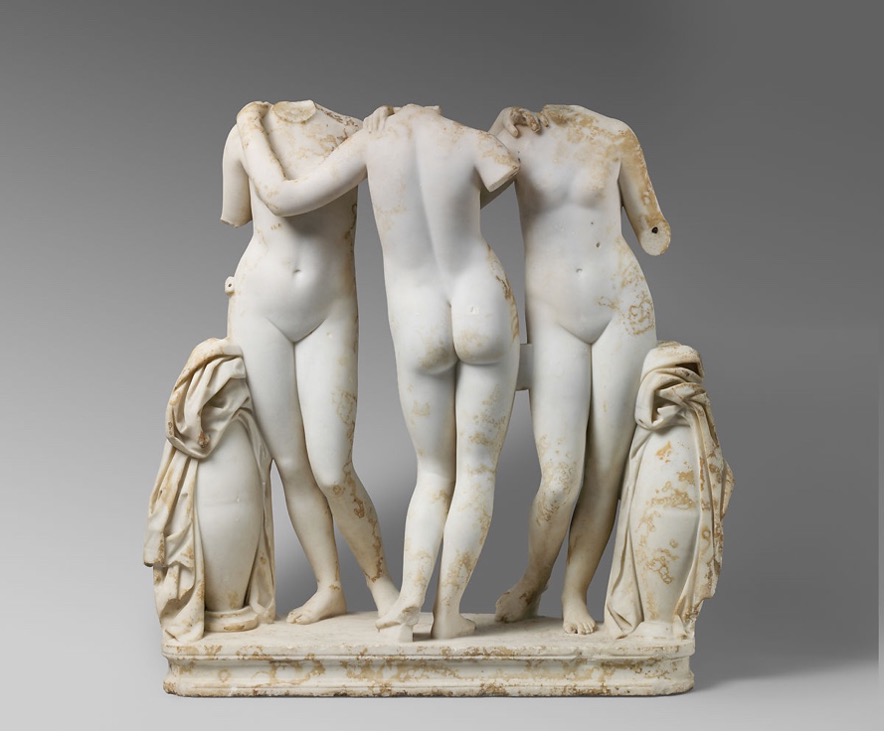
Figure 2. Roman Copy of Greek Three Graces. 2nd century A.D, marble, 123 x 100cm. Met Museum. Reproduced from: Met Museum. https://www.metmuseum.org/art/collection/search/256403#:~:text=These%20young%20girls%2C%20linked%20in,arts%2C%20harmonious%20reciprocity%20between%20men
Aristotle investigated theories of beauty and recommended representing nature as it ought to be (Manns 2015, 39). Association between representation and art was emphasised during the Renaissance, with Aristotle dominating many theories, but Plato too (Manns 2015, 39) and as a result, artists were having to choose between two incompatible aesthetic visions that either art should imitate nature, or that art should be more concerned with beauty (Ames-Lewis and Rogers 1998). The impasse of realism vs. idealism reverberated through the Renaissance (Haughton 2004) with Botticelli’s peers intent on realism, while he seemed indifferent to their aesthetic (Ames-Lewis and Rogers 1998), remaining interested in the stylistic, two-dimensional religious art of the Byzantine period (du Plessis 2022) (figure 3). Botticelli’s central Primavera figure, Venus, despite her flatness, is shown as beautifully languid, sinuous, and insightful with an inner pensiveness (Kuiper and McKenna 2009, 136). Renaissance art became more than a craft; it was a device which worked alongside philosophy (Tzioumis 2012) that could offer an ideal, of beauty and symmetry, as well as cathartic release, and it is from this perspective that Botticelli’s Primavera will be investigated.
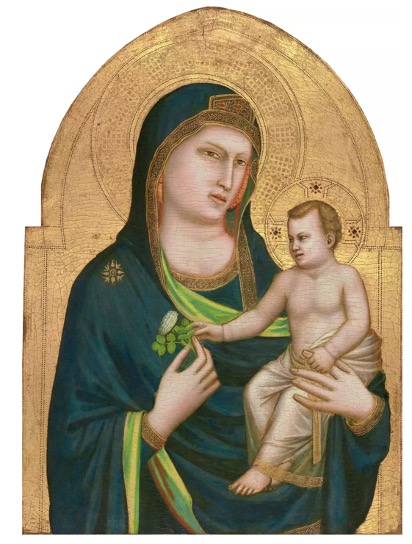
Figure 3. Giotto, Madonna and Child. 1320, tempera on panel, 85.6 × 62.1 cm. National Gallery of Art Washington DC. Reproduced from: Artsy. https://www.artsy.net/artwork/giotto-madonna-and-child
Perfectly symmetrical figures dominated the Renaissance (Haughton 2004) and Aristotle’s theories of beauty rested on mathematical formulas (Sartwell 2017, as quoted in Richards 2022, 216) where beauty was objective, could be measured (Humphreys n.d) and pertained to order, symmetry and greatness (Warry 2012). Primavera’s triangular composition creates spaciousness (figure 4) and this technique was pervasive in Italy and often seen in Madonna and child paintings like Raphael’s Alba Madonna (figure 5). Though we do not see the recently invented Renaissance linear perspective (Manns 2015, 39), Primavera’s spatial distance is still evident in its atmospheric perspective (d’Antonio 2021) suggesting a horizon line and vanishing point, and the sprawling yet organised orange grove forest extends rearward, showing equilibrium and harmony in nature. Almost life size, Botticelli has achieved greatness by its scale and compositional symmetry with figures repetitious in size and ordered neatly in a row that leads the eye through the work. The elongated narrow figures of Venus and the Three Graces have overemphasised necks, arms and hands, and stances that would render them off kilter (du Plessis 2022) giving an inaccurate portrayal of proportion, but symbiotically it provides a beauty ideal that is harmonious and otherworldly, especially with their diaphanous drapery, cascading hair and long fingers rhythmically patterned (d’Antonio 2021). Botticelli reinvigorated Aristotelian ideals of symmetry through a compositional arrangement that is equally balanced, orderly and of a grand scale.
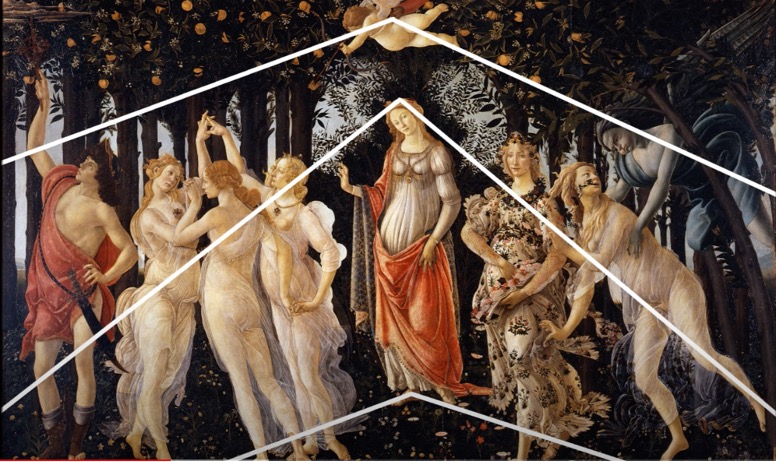
Figure 4. Sandro Botticelli, Primavera (with guide lines). 1482, egg tempera on wood panel, 203 x 314 cm. Art History Online. Reproduced from: https://www.youtube.com/watch?v=XhX3kWQCDyo
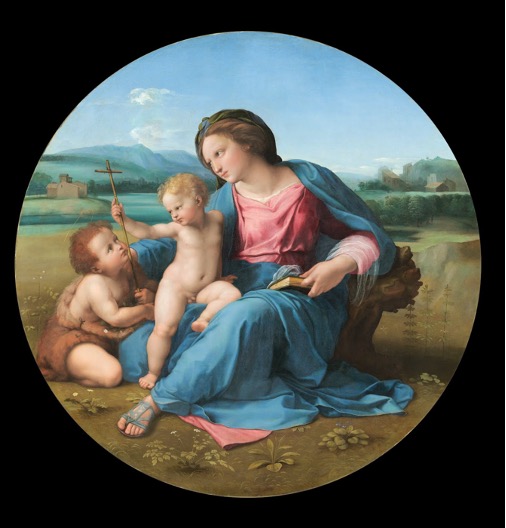
Figure 5. Raphael, The Alba Madonna. 1510, oil on panel, 945 cm tondo. Reproduced from: NGA. https://www.nga.gov/collection/art-object-page.26.html
Mimesis, or the imitation of nature held canonical importance to arts function for Aristotle (Preziosi 2009). Plato believed mimesis was a mere copy of reality that removed us further from truth (Manns 2015) and while Aristotle agreed that art was a representation of reality (Ketelsen 2003), Aristotle considered the imaginary rather than the real (Graham 2005) a more accurate rendition of reality and human potentiality (Manns 2015). During the Renaissance figures were carefully orchestrated into idealised representations to convey nature as it ought to be (ibid.), and Aristotle encouraged selecting parts of various models and blending them into composites of imagined figures (Warry 2012) into one, unified whole (Manns 2015, 40). The idealised figures in Primavera were ubiquitous to Botticelli and it is for this reason that Botticelli’s figures have similar characteristics that conform to beauty standards of the time, as seen in his Birth of Venus (figure 6) with its repetitive contrapposto, angelic hairstyles and elongated limbs. Art for Aristotle stimulates delight, upliftment (Lyas 1997) and pleasure, and the idealisation in the Primavera delivers in its widely sourced mimetic, amalgamated figures.
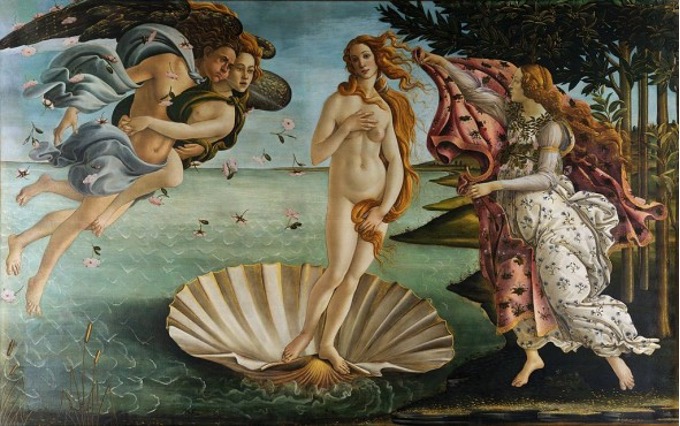
Figure 6. Sandro Botticelli, The Birth of Venus. 1486, tempera on canvas, 172.5 cm × 278.9 cm. Galleria Degli Uffizi. Reproduced from: Italian Renaissance. http://www.italianrenaissance.org/botticelli-birth-of-venus/.
Aristotle saw that catharsis was admirable and could be achieved through art by experiencing tragedy. Opposing his teacher Plato (Ketelsen 2003) who considered the coaxing of emotions deleterious to personal contentment that weakened one’s character (Manns 2015), Aristotle spoke of catharsis in his Poetics as holding the necessary function of purifying repressed, base emotions from one’s consciousness (Carneades 2020), which he encouraged (Manns 2015). After the plague, Florence’s natalism policy vigorously promoted repopulation (Armstrong 2021), and marital sex’s sole purpose was procreation (LeBaron 2021) as civic virtue (Krohn 2008). Marriages continued to be arranged (Zirpolo 1991) and often began with violent rape (LeBaron 2021), a widespread occurrence based on cultural practices at the time (Richards 2021). Primavera depicts a secular narrative of Renaissance lovers (Kuiper and McKenna 2009), with Cloris (far right) aggressively abducted and raped by Zephyr (Tzioumis 2012). His geometric, sharply angled figure and facial expression connote violence in his furrowed brow, pursed lips and tight grip on Cloris, whose expression shows marked fear and terror, to purge young brides of forced submission. Aristotle also remarked that tragedy is used to show an evolution of the central character from ignorance to knowledge (Humphreys n.d.)and Primavera illustrates the metamorphosis of despair to renewal from Cloris to Flora to Venus. Primavera’s horrible event succeeds because of its intense power to purge our discomfort through portraying not just figures but states of feeling (Manns 2015). This well-crafted artistic representation suggests the personality and temperament of the figures by action, stance, and facial expression, coercing a response, and here Botticelli facilitates catharsis worthy of Aristotle’s endorsement.
Truly aesthetically pleasing art has embodied approbation over millennia. Primavera successfully signifies Aristotelian precepts of catharsis for release, visual symmetry for balance and idyllic mimesis as quintessentially imperative for Botticelli in the 15th century Renaissance. The legacy of Aristotle’s philosophy of art resounded through the classical revival of the Renaissance with great fury and dedication, and Primavera stands as an enigmatic visual tale that at once rouses our emotional lives with the beauty and tragedy of life, its cultural norms and our place within it.
REFERENCE LIST
Alicia du Plessis. 2021. “Botticelli Paintings – The Most Famous Works of Sandro Botticelli”. Art In Context. https://artincontext.org/botticelli-paintings/
Alicia du Plessis. 2022. “The Birth of Venus” Botticelli – An Analysis of the Birth of Venus Painting”. Art In Context. https://artincontext.org/the-birth-of-venus-botticelli/#Proportions
Ames-Lewis, Francis and Mary Rogers. 1998. Concepts of Beauty in Renaissance Art. UK: Taylor & Francis Group.http://ebookcentral.proquest.com/lib/curtin/detail.action?docID=5631878.
Armstrong, Dorsey. 2021. “How Order Was Restored in Florence after the Black Death.” Wondrium Daily. https://www.wondriumdaily.com/how-order-was-restored-in-florence-after-the-black-death/
Campbell, Gordon. 2019. The Oxford Illustrated History of the Renaissance. Oxford: Oxford University Press Incorporated.
Carneades. 2020. What is Catharsis? (Aristotle’s Poetics). https://www.youtube.com/watch?v=8nCZjfmwxtM
Charles, Victoria. 2010. Renaissance Art. New York: Parkstone International. http://ebookcentral.proquest.com/lib/curtin/detail.action?docID=887044.
d’Antonio, Luisa. 2021. Italian Renaissance Art: Analyse Primavera by Botticelli. https://www.youtube.com/watch?v=e2sqfPkBrdY
De Witte, Melissa. 2020. “For Renaissance Italians, Combating Black Plague Was As Much About Politics As It Was Science, According to Stanford Scholar.” Standford. https://news.stanford.edu/press-releases/2020/05/12/combating-black-politics-science/.
Graham, Gordon. 2005. Philosophy of the Arts: An Introduction to Aesthetics. UK: Taylor & Francis Group.
Haughton, Neil. 2004. “Perceptions of beauty in Renaissance art.” Journal of Cosmetic Dermatology 3 (4): 229-233. https://doi.org/10.1111/j.1473-2130.2004.00142.x.
Humphreys, Justin. N.d. “Aristotle.” Internet Encyclopedia of Philosophy: A Peer Reviewed Academic Resource. https://iep.utm.edu/aristotle/.
Ketelsen, Christian. 2003. “Aristotle, Art, and Greek Tragedy.” Washington State University. https://public.wsu.edu/~kimander/aristotleart.htm
Krohn, Deborah. 2008. “Weddings in the Italian Renaissance.” Met Museum. https://www.metmuseum.org/toah/hd/wedd/hd_wedd.htm
Kuiper, Kathleen and Amy McKenna. 2009. The 100 Most Influential Painters and Sculptors of the Renaissance: 100 Most Influential Painters and Sculptors of the Renaissance. Rosen Publishing Group
LeBaron, Garn. 2021. “Sexual Relations In Renaissance Europe.” The Garn LeBaron Writing Project. Scholarly Articles About Interesting Subjects. https://garnlebaron.wordpress.com/sexual_relations_in_renaissance_europe/.
Lyas, Colin. 1997. Aesthetics. London: UCL Press.
Manns, James. 2015. Philosophy and Aesthetics. New York: Routledge.
Preziosi, Donald. 2009. Art of Art History: A Critical Anthology. UK: Oxford University Press. http://ebookcentral.proquest.com/lib/curtin/detail.action?docID=453635.
Richards, Richard. 2022. Naturalized Aesthetics. New York: Routledge.
Tzioumis, Leatha. 2012. “Boticelli’s la primavera: Painting the cosmos of human ideals.” PhD diss., University of Massachusetts. https://www.proquest.com/dissertations-theses/boticellis-la-primavera-painting-cosmos-human/docview/1140330961/se-2?accountid=10382
Warry, J. G. 2012. Greek Aesthetic Theory (RLE: Plato). UK: Taylor & Francis Group. http://ebookcentral.proquest.com/lib/curtin/detail.action?docID=1092729.
Whittemore, Jessica. N.d. https://study.com/academy/lesson/humanism-in-the-renaissance-recognizing-the-beauty-of-the-individual.html
Zirpolo, Lilian. 1991. “Botticelli’s ‘Primavera’: A Lesson for the Bride.” Woman’s Art Journal 12 (2): 24–28. https://doi.org/10.2307/1358279.
BIBLIOGRAPHY
Aristotle. 2000. Nicomachean Ethics Translated by W. D. Ross.
USA: Infomotions Inc. https://ebookcentral.proquest.com/lib/curtin/reader.action?docID=3314407.
Aristotle’s Nicomachean Ethics : A Critical Guide, edited by Jon Miller, Cambridge University Press, 2011. ProQuest Ebook Central, https://ebookcentral.proquest.com/lib/curtin/detail.action?docID=775106.
Art History Online. 2017. Sandro Botticelli – La Primavera (1482). https://www.youtube.com/watch?v=XhX3kWQCDyo
Art In Context. 2022. “Egyptian Art – An Exploration of Ancient Egyptian Art and Its Influences.” Art In Context. https://artincontext.org/egyptian-art/
Balasz Takac. 2020. “Botticelli’s Primavera.” Widewalls. https://www.widewalls.ch/magazine/botticelli-primavera
Broude, Norma and Mary Garrard. 2018. Feminism and Art History. New York: Routledge.
Cartwright, Julia. 2016. The Life and Art of Sandro Botticelli. London: Duckworth and Co. http://wisteriafield.jp/botticelli-life-and-art/botticelli_life_and_art.html
Crash Course. 2016. Aesthetics: Crash Course Philosophy #31.https://www.youtube.com/watch?v=gDL4Zf2yEa4
De Campos, Deivis, Tais Malysz, João Antonio Bonatto-Costa, Geraldo Pereira Jotz, Lino Pinto de Oliveira Junior, Jéssica Francine Wichmann, Guilherme Reghelin Goulart, Marco Antonio Stefani and Andrea Oxley da Rocha. “Pagan symbols associated with the female anatomy in the Medici Chapel by Michelangelo Buonarroti.” Clinical Anatomy 30 (5): 572-577. https://doi.org/10.1002/ca.22882.
Dee, John. 2013. “Eclipsed: An Overshadowed Goddess and the Discarded Image of Botticelli’s ‘Primavera.’” Renaissance Studies 27 (1): 4–33. http://www.jstor.org/stable/24420217.
Deguzman, Kyle. 2021. “What is Catharsis — Definition & Examples for Storytellers.” Studio Binder. https://www.studiobinder.com/blog/what-is-catharsis-definition/
Eco, Umberto. 2010. On Beauty. London: MacLehose Press.
Frist Art Museum. 2019. “Life, Love & Marriage Chests in Renaissance Italy.” Frist Art Museum. https://fristartmuseum.org/exhibition/life-love-marriage-chests-in-renaissance-italy/#:~:text=In%20Renaissance%20Italy%2C%20arranged%20marriages,by%20a%20decade%20or%20more.
Gaut, Berys and Dominic Lopes. 2013. The Routledge Companion to Aesthetics. UK: Taylor & Francis Group. https://ebookcentral.proquest.com/lib/curtin/detail.action?docID=1172918.
Gebhart, Emile and Victoria Charles. 2010. “Botticelli”. New York: Parkstone International.
Gray, Robert. 2019. Art Therapy and Psychology. New York: Routledge.
Grimes, Pierre. 2007. The Platonic Understanding of Art (Part 1). https://www.youtube.com/watch?v=pwpLAd6uhsE
Harrison-Barbet, Anthony. 2001. 2nd ed. Mastering Philosophy. USA: Palgrave.
Huffman, Carl. 2018. “Pythagoras”. The Stanford Encyclopedia of Philosophy. https://plato.stanford.edu/archives/win2018/entries/pythagoras.
Janaway, Christopher. 2005. Companion to Aesthetics: Plato. USA: Routledge.
Kotzin, Michael. 1966. “Pre-Raphaelitism, Ruskinism, and French Symbolism.” Art Journal 25 (4): 347–50. https://doi.org/10.2307/774952.
Liebeschuetz, Wolfgang. 1995. “Pagan Mythology in the Christian Empire.” International Journal of the Classical Tradition 2 (2): 193–208. http://www.jstor.org/stable/30222200.
Marmor, Max. 2003. “From Purgatory to the Primavera: Some Observations on Botticelli and Dante.” Artibus et historiae 24 (48): 199-212. http://archiv.ub.uni-heidelberg.de/artdok/194/1/Marmor_From_Purgatory_to_the_Primavera.pdf
Matthen, Mohan. N.d. “Eye Candy.” Aeon. https://aeon.co/essays/how-did-evolution-shape-the-human-appreciation-of-beauty
Max Planck Institute. 2017. “Beautifully Sad: Why We Enjoy Negative Emotions in Movies and Art.” Neuroscience News. https://neurosciencenews.com/movies-negative-emotions-8104/
Met Museum. N.d. “Marble Statue Group of the Three Graces.” Met Museum. https://www.metmuseum.org/art/collection/search/256403#:~:text=These%20young%20girls%2C%20linked%20in,arts%2C%20harmonious%20reciprocity%20between%20men.
Miller, Jon. 2011. Aristotle’s Nicomachean Ethics: A Critical Guide. USA: Cambridge University Press. https://ebookcentral.proquest.com/lib/curtin/detail.action?docID=775106.
Neuendorf, Henri. 2016. “Art Demystified: Why Do Contemporary Artists Use So Many Studio Assistants? Warhol’s Factory May Be To Blame.” Artnet. https://news.artnet.com/art-world/art-demystified-the-use-of-assistants-549284
Passavant, Günter. N.d. “Andrea del Verrocchio”. Britannica. https://www.britannica.com/biography/Andrea-del-Verrocchio#ref140534
Prettejohn, Elizabeth. 2005. Beauty and Art: 1750-2000. USA: Oxford University Press. https://ebookcentral.proquest.com/lib/curtin/detail.action?docID=422707.
Robichaud, Denis. 2018. Plato’s Persona: Marsilio Ficino, Renaissance Humanism, and Platonic Traditions. USA: University of Pennsylvania Press. http://ebookcentral.proquest.com/lib/curtin/detail.action?docID=5380470.
Scarry, Elaine. 2001. On Beauty and Being Just. Princeton: Princeton University Press.
Scruton, Roger. 2008. Beauty: A Very Short Introduction. USA: Oxford University Press. https://ebookcentral.proquest.com/lib/curtin/detail.action?docID=746774.
Sotiropoulou-Zormpala, Marina and Alexandra Mouriki. 2020. Enriching Arts Education Through Aesthetics. New York: Routledge.
The School of Life. 2015. The Renaissance. https://www.youtube.com/watch?v=csIW4W_DYX4
The School of Life. 2016. Plato On; The Forms. https://www.youtube.com/watch?v=MgotDFs6cdE
Turner, Lucille. 2016. “Botticelli and Da Vinci – Two Artists, Two Visions.” Lucille Turner. https://lucilleturner.com/botticelli-and-da-vinci-two-artists-two-visions-2/
White, Katie. 2021. “Sandro Botticelli’s Primavera Is a Mysterious Celebration of Spring.” Artnet. https://news.artnet.com/art-world/sandro-botticelli-primavera-4-things-to-know-1937013
Woods-Marsden, Joanna. 1987. “‘Ritratto al Naturale’: Questions of Realism and Idealism in Early Renaissance Portraits.” Art Journal 46 (3): 209–216. https://doi.org/10.2307/777034.